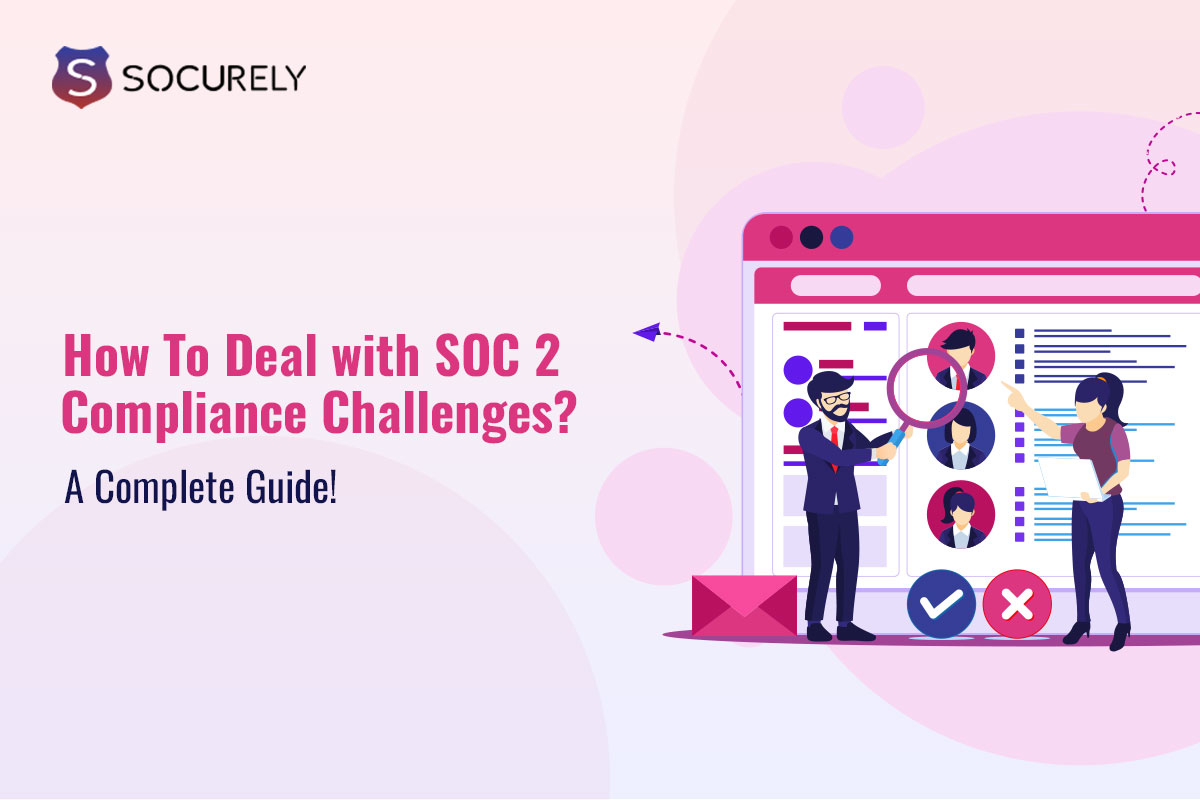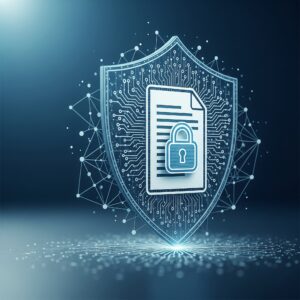The extent, frequency, and size of cyberattacks are all increasing. The percentage of targeted firms has increased from 38% to 43% in just the last year, and more than 25% of them had five or more attacks (as per 2021 reports). In terms of security, the internet is still uncharted territory. Customers seek guarantees that the supply chains they rely on are safeguarded as an increasing number of companies transition to SaaS-based delivery methods. It is when SOC 2 Compliance comes into play with other cybersecurity needs like ISO 27001, PCI DSS, GDPR Compliance, and more.
In this comprehensive guide, we’ll delve into the intricacies of SOC 2 compliance, exploring the challenges you may face and providing actionable strategies to overcome them.
SOC 2 Compliance
Developed by the American Institute of CPAs (AICPA), SOC 2 is a voluntary compliance standard that specifies how companies handling client data should handle it. The security, availability, processing integrity, confidentiality, and privacy Trust Services Criteria form the basis of the standard.
For industry leaders, achieving SOC 2 compliance is essential not only for maintaining regulatory compliance but also for building trust with customers and partners. It offers consistent, independent verification of the measures put in place by an organization to continuously reduce risk associated with information.
In a brief note, a company that has received a SOC 2 report from a CPA firm indicates that its data security procedures have been successfully planned and validated. An audit that was conducted at a particular moment is indicated in a Type 1 report. Because a Type 2 report spans time, it guarantees that controls are consistent.
Five Trust Service Criteria of SOC 2 Compliance-
A comprehensive set of controls founded on five trust service criteria is reported by SOC 2 compliance audits.
- Security against system damage, unlawful disclosure, and unauthorized access.
- Availability in a state of operation and availability that satisfies specified business goals.
- Process Integrity guarantees the accuracy, completeness, and reliability of the system’s operations and processes, ensuring data is processed correctly, securely, and as intended, without unauthorized alteration or loss.
- Confidentiality safeguards private information at every stage of its existence, from gathering and handling to discarding.
- Privacy in personal data, particularly that which is obtained from clients.
For SOC 2 Compliance, maintaining these criteria is necessary. Organizations from different industries can get these criteria overall.
Top 6 Challenges of SOC 2 Compliance & Overcoming The Same-
1. Understanding Complex Requirements:
Challenge:
The intricate nature of SOC 2 criteria often poses a significant challenge for organizations, making it difficult to comprehend and implement the necessary controls effectively. This complexity can lead to confusion among stakeholders, delaying the compliance process and potentially exposing the organization to risks.
Solution:
To address this challenge, organizations should invest in SOC 2 Compliance offered by the best compliance security firm. Organizations can enhance stakeholders’ understanding of SOC 2 criteria, fostering a culture of compliance and accountability. Additionally, leveraging external experts or consultants specializing in SOC 2 compliance can provide valuable insights and guidance, helping organizations navigate the complexities more effectively.
Socurely provides a clean and comprehensive list of requirements and their pre-mapped controls, making navigation through the framework complexity much faster and easier.
2. Resource Constraints:
Challenge:
Limited resources, both in terms of time and personnel, can impede organizations’ ability to dedicate sufficient efforts to SOC 2 compliance initiatives. This constraint may result in inadequate planning, execution, and oversight of compliance activities, jeopardizing the organization’s ability to achieve and maintain SOC 2 compliance.
Solution:
While overcoming resource constraints, organizations should prioritize SOC 2 compliance as a strategic initiative. They should allocate adequate resources, including personnel, budget, and technology, to support compliance efforts in the organization.
Socurely offers experts and support to help organizations prioritize SOC 2 compliance as a strategic initiative, ensuring adequate resource allocation and optimized compliance efforts. They bring you the real-time Soc 2 requirements for your business making the resource availability faster and convenient.
3. Addressing Scope Creep:
Challenge:
Scope creep, wherein the scope of SOC 2 compliance initiatives expands beyond initial estimates or expectations, is a common challenge faced by organizations. This phenomenon can occur due to evolving business processes, regulatory changes, or the discovery of previously unidentified risks, leading to delays and disruptions in the compliance process.
Solution:
To mitigate the risks associated with scope creep, organizations should conduct thorough scoping exercises at the outset of SOC 2 compliance initiatives, clearly defining the boundaries and objectives of the compliance program.
Socurely’s comprehensive scoping exercises and robust change management processes, help organizations to proactively identify and address potential scope creep issues. Also, our deep communication with compliance teams, business units, and senior management, ensures alignment and growth for your business.
4. Managing Third-Party Relationships:
Challenge:
Many organizations rely on third-party vendors and service providers to support their business operations, introducing complexities and challenges in managing third-party relationships while ensuring SOC 2 compliance. Inadequate oversight of third-party activities and dependencies can pose significant risks to organizations, potentially leading to compliance failures and data breaches.
Solution:
Vendor management programs are essential for managing third-party relationships and mitigating compliance risks. As a result, third-party vendors must be thoroughly assessed for compliance posture and security controls, and contractual obligations regarding SOC 2 compliance requirements must be established.
Socurely team of SOC Compliance professionals assists your organization with the vendor management program, to control third-party vendors for compliance posture and build robust security controls. Socurely establishes the contractual obligations report regarding SOC 2 compliance requirements for your security.
5. Ensuring Data Protection and Privacy:
Challenge:
Data protection and privacy concerns are paramount in SOC 2 compliance, particularly with the increasing focus on safeguarding sensitive information and personal data. Organizations face challenges in implementing robust data protection measures, including encryption, access controls, and data minimization, to meet SOC 2 requirements while balancing business objectives and operational efficiency.
Solution:
To address data protection and privacy challenges, organizations should adopt a risk-based approach to data governance, identifying and prioritizing the protection of sensitive information based on its criticality and regulatory requirements.
Socurely implementing comprehensive data protection frameworks, such as encryption protocols, access controls, and data classification schemes, to help organizations establish a strong foundation for SOC 2 compliance while minimizing data-related risks. Additionally, ongoing monitoring, auditing, and training programs are also offered to ensure compliance with data protection regulations and SOC 2 requirements.
6. Maintaining Continuous Compliance:
Challenge:
Maintaining continuous compliance with SOC 2 requirements is an ongoing challenge for organizations, as compliance is not a one-time event but a continuous process that requires regular monitoring, assessment, and improvement. Changes in business processes, technology landscapes, and regulatory environments can impact compliance status, requiring organizations to adapt and evolve their compliance programs accordingly.
Solution:
To achieve and maintain continuous compliance with SOC 2 requirements, organizations should establish a robust compliance management framework that encompasses policies, procedures, controls, and monitoring mechanisms.
Socurely automated compliance tools and technologies can streamline compliance processes, enabling organizations to efficiently gather evidence, conduct assessments, and track compliance status in real-time. Regular internal audits, external assessments, and compliance reviews offered by Socurely identify areas for improvement and reduces compliance gaps, ensuring ongoing adherence to SOC 2 requirements.
Conclusion:
Achieving SOC 2 compliance is a critical step for industry leaders committed to upholding the highest standards of data security and trustworthiness. By understanding the challenges associated with SOC 2 compliance and implementing best practices, you can ensure that your organization is well-prepared to navigate the complexities of regulatory compliance and safeguard sensitive information effectively. With the right strategies and partnerships in place, mastering SOC 2 compliance is within reach for industry leaders dedicated to data protection and integrity.







